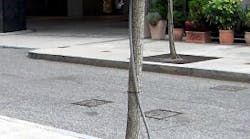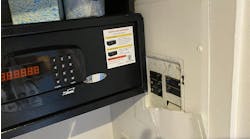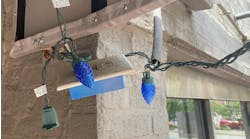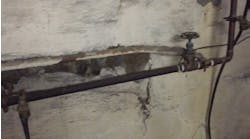No Room for Growth
When I took this photo, my first thought was: What happens when the tree grows taller? My second thought: What happens when the zip tie breaks? The inspector could develop a list of code violations that would run off of this page!
These receptacles are fed by an underground liquidtight flexible metal conduit (LFMC), which exits the ground and continues right up the tree to the weather-resistant box. The receptacles are used to provide power for holiday lighting. This installation violates the requirements of 300.5(D)(4), which states, “Where the enclosure or raceway is subject to physical damage, the conductors shall be installed in rigid metal conduit, intermediate metal conduit, Schedule 80 PVC conduit, or equivalent.”
Failed to Live Up to Expectations
It’s interesting to note this box was never secured to the brick wall. I guess the installer thought the set screw on the electrical metallic tubing connector was designed to support the weight of the box and its contents. As you can clearly see, the box has been knocked loose, exposing the energized conductors feeding this receptacle.
As most all of you should know, the purpose of the NEC is “the practical safeguarding of persons and property from hazards arising from the use of electricity.” As noted in 90.1(B), “This Code contains provisions that are considered necessary for safety. Compliance therewith and proper maintenance results in an installation that is essentially free from hazard but not necessarily efficient, convenient, or adequate for good service or future expansion of electrical use.”
CORRECTION
There was an error in the November 2010 issue of “Illustrated Catastrophes” on page 42. At the bottom of the second item, “Floating Free,” the last sentence should have read: “The grounding electrode conductor should have been installed on the opposite side of the connector, in the V-shaped groove of the fitting.”





